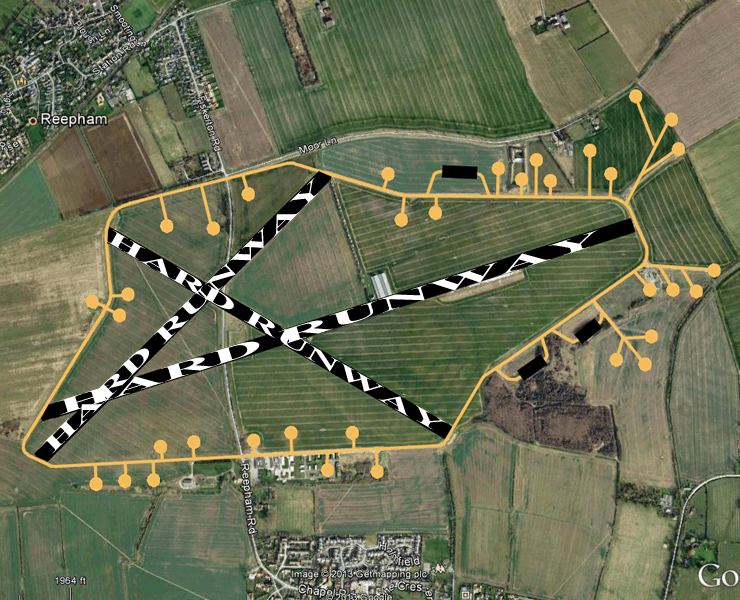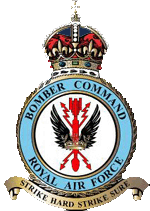Fiskerton Airfield History

(Map edited to show the airfield and runways between 1940-45)

© Crown Copyright/MOD 2010
53°14'34.30"N 0°26'7.37"WRunways:
05/23 & 13/31 4200ft x 150ft - 08/26 6000ft x 150ft
Construction on the airfield at Fiskerton began life in early 1942, and opened in November the same year. Only 4.5 miles east of Lincoln, the airfield was constructed to Class A standard on the west side of Fiskerton Moor, south-east of the LNER line from Lincoln to Market Rasen. In order for the new station to be built, the road from Fiskerton village to Reepham had to be closed. Two of the main construction companies involved in building the airfield were F.G. Mintee Ltd and Constable Hart & Co. Ltd, both of which were only involved in the later stages of construction. But a number of smaller companies were also involved in the building process, mainly in the early stages.
The normal 36 hardstandings were provided, all of which were the standard pan type, but one was lost with the erection of a T2 hangar on the north side between runway heads 23 and 26. Another T2 and a B1 were erected near the technical site on the east side between runway heads 26 and 31, the B1 being the southernmost. The bomb stores were positioned to the north between runway heads 13 and 23. Most of the domestic sites were dispersed in fields close to the Fiskerton village to Stainfield road, comprising of seven domestic, two communal, one WAAF and sick quarters. Maximum accommodation was 2016 males and 297 females.
Despite the station being completed in November 1942, it wasn’t to receive its first residents until 2nd January 1943 with the arrival of No.49 Squadron from RAF Scampton. With the arrival of its first squadron came the airfields first aircraft in the form of the Avro Lancaster. With the station now active, it was assigned to 5 Group, Bomber Command, and became a sub-station for 52 Base, with had established at near-by Scampton.
No.49 Sqn’s stay was to be short lived though, and they were forced to leave the station due to the runway at the airfield starting to break up. So on the 13th September 1943 they left the station heading for nearby RAF Dunholme Lodge, but were later to return to the airfield on the 24th October 1943.
During this period of inactivity not only was the runway repaired, but they also took this opportunity to install the fog dispersal system called FIDO (Fog Investigation Dispersal Organisation). But the installation of this system initially caused a number of problems for pilots when landing. The updraught from the heat and the glare from the flames was impairing the pilots visibility when landing. One Lancaster landing there was said to have made several attempts to land before finally getting the aircraft down. But these early problems were soon overcome once the pilots got more accustomed to the conditions.
As at most airfields with the FIDO system installed, it was used as a last resort, due not only to the high cost of petrol, but also the amount of petrol the system used. On a single burn during December 1944, the system used a massive 188,000 gallons of petrol. At the time Fiskerton was one of only 15 airfields to receive this newly developed system. More activity was to take place at the station on the 2nd January 1944, the airfield became the home of 1514 Beam Approach Training Flight, bringing with them the Airspeed Oxford.
More change was to take place in October 1944, when 52 Base was transferred to 1 Group, Bomber Command on the 7th October; with this the station became a sub-station of 15 Base. However No.49 Sqn remained under the command of 5 Group, and subsequently left the airfield on the 16th October 1944.
With this move, it left the station with only the resident BAT flight and a single detachment of No.141 Sqn which had arrived on the 4th September with its Mosquitos, as the only operating aircraft at the airfield. But they were soon joined by the first arrival from 1 Group, No.576 Squadron. They arrived on the 30th October, and only two days later, on the 1st November, they were joined by No.150 Squadron which was formed at the station. With the arrival of both squadrons brought an abundance of Avro Lancasters to the airfield.
No.576 Sqn were to have no rest bite after their move from Elsham Wolds. The squadron arrived at the airfield early in the morning, but within only a few hours both the aircraft and the crew were being prepped for their first mission, a night raid on Cologne. Over the coming months this relentless pace was kept up, and the squadron was involved in a variety of missions. These were to include several daylight raids and a number of raids on Essen.
.jpg)
© Ken Stott - No.576 Sqdn Disbandment 13th September 1945
It was all change again at the end of November 1944, when the newly formed No.150 moved for pastures new to RAF Hemswell on the 22nd November 1944. This was shortly followed by the disbandment of the station BAT flight on the 9th January 1945. With the war now seemingly drawing to a close, there was a re-organisation within 1 Group, Bomber Command. The former ‘C’ flight of No.625 Sqn were moved to the station on the 5th April 1945, to become the new ‘C’ flight of No.576 Sqn. The very same day also saw the arrival of the 1 Group Bombing-Up School from RAF Scampton. It was soon all change again at the station when on the 3rd July 1945, the Mosquitoes of the single No.141 Sqn detachment at the station left. This was shortly followed the disbandment of No.576 Squadron on the 13th September 1945.
No.576 Sqn’s last operational mission took place on the 25th April 1945, when they were tasked with bombing Berchtesgaden. Although it’s final flight during the war was to drop supplies to the Dutch in Rotterdam. The squadron’s final loss of the war was to come only hours before the end of the war on VE Day. Lancaster NN806 was tasked with a food drop in Holland, but swung-off the runway during take-off. But surprisingly the only injury reported was a sprained wrist to F/O G.R Cross.
During operations from the airfield, a total of 117 Lancasters were lost from the two resident bomber squadrons.
With WWII now over, No.15 Base was disbanded and the station handed over to 40 Group, Maintenance Command on the 20th November 1945. With this, the airfield as placed on Care and Maintenance on the 15th December 1945, but the main runway was kept open emergency use only. 1947 saw the former dispersed hutted accommodation sites allocated to the Ministry of Health for use as emergency housing for the homeless.
Four sites were used on the Bardney Road for accommodation; The Crescent, Ferryside; Woodlands and Longwood. Another four were used on the accommodation access road; Hallfields, Fenlands, Moorlands and Birchill. The Sergeant mess on Site 3 was used as the village school, and continued in use up until 1970.
1954 saw a Protected Group Control centre built at the airfield adjacent to the former technical site. This was for use by 15 Group, Royal Observers Corps, and funded by the Home Office as part of a civil defence programme. They remained at the airfield until they were stood down in July 1991, and finally disbanded in September the same year.
Slowly over the coming years the airfield fell into disrepair until 1963-64, when the 630 acre site was finally sold-off to the local farmers.
Since the former airfield was sold-off, it has been used for a variety of purposes. Oil was discovered under the airfield in 1977, with production of it starting a year later in 1978. Two pumps were built to extract the oil next to the South Eastern peri-track, at the end of the former Technical site. Since the first discovery of oil under the airfield, numerous surveys have taken place turning up more pockets of oil.
As for the airfield itself, very little remains. The majority of the buildings including the hangars and control tower have long since been demolished. Only parts of the peri-track remain, giving an indication of its former use. There are also some small areas of runway concrete remaining, along with the concrete bases of a few buildings.
In 1995 a memorial was erected on the roadside near the old main runway, to remember all the aircrews from both No.49 Sqn and No.576 Sqn that never returned the once proud airfield.
| Date | Squadron | Notes |
|---|---|---|
| January 1943 | Station opens. | |
| January 1943 | No.49 Sqn | Operating the Avro Lancaster. Left Fiskerton in October 1944. |
| September 1944 | Station runways repaired and FIDO system installed. | |
| October 1944 | No.576 Sqn | Operating the Avro Lancaster. Squadron disbanded in September 1945. |
| September 1945 | Station closed and put on care and maintenance. | |
| November 1945 | No.61 MU | Left Fiskerton in November 1948. |
| November 1948 | No.93 MU | Left Fiskerton in February 1954. |
| 1954 | Royal Observers Corps | R.O.C. opened main Headquarters. Disbanded in September 1991. |
| 1992 | RAF Fiskerton completely sold off for agricultural use. |
.jpg)
.jpg)
